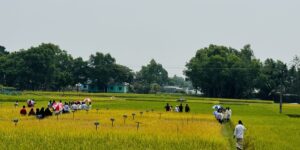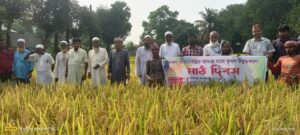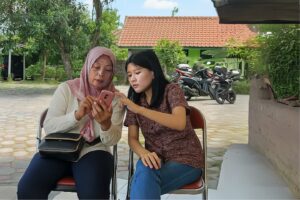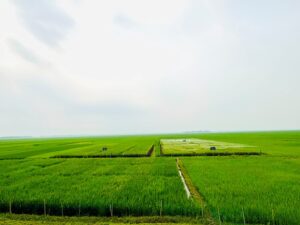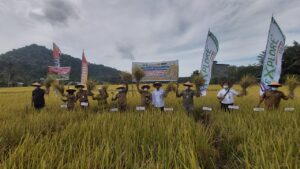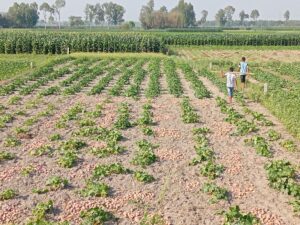As the sun rises and casts its first beams of light over the experimental rice fields at the International Rice Research Institute (IRRI), there is a flurry of activity of birds coming in to feed, or leaving the rice fields to roost for the day. They are everywhere—in the air, on the roads, and between the fields. This usually occurs between 5:30 and 6:30 in the morning.
Rice fields create a unique habitat within agriculture. Unlike other crops, rice is almost constantly flooded—an artificial wetland, which is very attractive to birds of all kinds, especially if the local natural wetland is drier than usual or has been lost.
Rural myth
Studies have been conducted on birds in rice fields although research has been mostly within the U.S. or Europe. In Asia, however, little work has been conducted on this topic. Thus, knowledge gathered by farmers on birds and their effect on the crop comes through hearsay and speculation.
What exactly do these feathered creatures do in rice fields and do we want to keep them or eradicate them?
The biggest myth about birds is that all of them eat rice.This just isn’t true. Observations conducted within the IRRI experimental farm, during the reproductive and ripening phases of the rice crop, found more than 50 different bird species, but only four are known to feed on rice. The majority of the others feed on insects only.
Easy targets
“If it flaps, scare it away!” This idea common in rice farming might be causing more harm than good, especially at certain times of the year. Different birds have different diets, and distinguishing the “good guys” from the “bad guys” can become difficult.
Here are some of the “good guys”:
- Egrets, the white birds often seen in rice fields, eat some invertebrates as well as fish, crustaceans, frogs, and reptiles.
- Herons and bitterns, often scared out of rice fields, also eat fish, crustaceans, frogs, reptiles and aquatic insects, snails, and some small mammals.
- Finally, birds of prey that can be found in a rice habitat, such as pied harriers and grass owls, hunt mammals within the fields, but also keep the number of smaller birds down.
All of these are easily targeted by farmers as they are large and relatively easy to catch, but they could be helping the crop through pest management. For example, the tree sparrow is common throughout the Philippines, but is endangered in the United Kingdom, with many conservation programs trying to save the remaining population. There are even farmer incentives to promote the habitat the birds require in an effort to entice them back. Studies in the UK have shown that they eat only invertebrates during breeding, as they require more protein in their diet.
Convicted without evidence
The alleged bad guys are those that are known as maya. This Tagalog word is used to describe a particular bird that feeds on rice grain. However, there is a common misconception within the Philippines in the use of that word. Maya actually refers to four different bird species, all of which can be found at IRRI.
These are tree sparrows (Passer montanus) and three species of munias (Lonchura spp.) that are in the Philippines: chestnut, scaly-breasted, and white-bellied. Although these birds eat rice grains in at least part of the year, effective species management requires a better understanding of their lifestyle and behavior.
These birds are seen periodically feeding in rice fields and sometimes from the plants directly. However, how much damage they are actually causing is unknown. With birds able to fly great distances and no systematic method of feeding (that we know of), recording this damage would require surveying a large number of rice fields over a long time. Indirect methods of damage assessment include mathematical models and farmer estimations. However, these all rely on farmers’ ability to accurately record bird flocks, movements, and locations, as well as all the other factors that contribute to yield loss. A standard method of quantifying bird damage in rice fields still needs to be developed.
Winged scapegoats
Why do birds get blamed? Maybe it has something to do with their skill, which we all wish we had—they can fly! It seems that their major advantage in the wild is one of the main reasons they have gained a reputation for damaging rice.
Farmers often point out flocks of birds flying out of their fields. More often than not, farmers have not seen where these birds have come from, and they do not know what these birds have been eating, but they do see them leaving the fields.
Although other pests, such as rats, display physical and measurable damage to rice, birds do not. Farmers cannot always see rats move within the fields, but they do see birds.
To ponder upon
With few bird deterrents available, little can be done to prevent birds from flying in or out of fields and methods of control need to be enhanced. All birds are so incredibly intelligent that they can habituate themselves to new stimuli quickly. For example, standing a flag close to a field in an attempt to scare birds only provides them with a new perch on which they can sit. The use of “bird scarers” will work only as long as the method of scaring, either rattling tin cans or shouting, is ever-changing.
It would also help if one understood which birds to scare and which ones to leave alone. To completely “bird-proof” a rice crop, planting in greenhouses or under nets is the only option. But, this will disable the positive effects that some birds provide—a delicate balancing act that will be understood only if further research into the species seen in rice, particularly their behavior and lifestyle, is conducted.
So, the next time you are in a rice field, take a moment to look up and see what is close by. Chances are you will be very close to some of our feathered friends. Watch as the egrets chase aquatic prey between the rice hills or as the swallows sweep over the top, collecting flying insects as they go. Take a moment to marvel as they duck and dive through the air and just think of how rice provides a benefit to many species, not just by providing food.
____________________
Mr. Smedley started his PhD at theUniversity of Reading, UK in 2011. He is continuing his studies as an IRRI scholar in the Crop and Environmental Sciences Division. He enjoys studying the birds in the experimental fields, as well as sites in Isabela and Bohol provinces in the Philippines.

